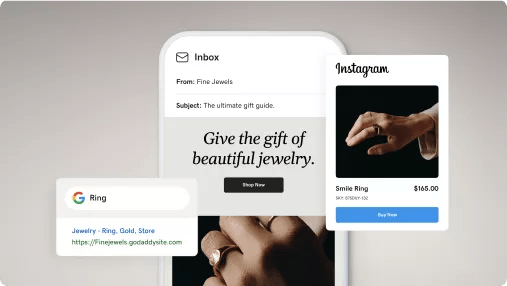Empower Your Brand with The Ad Firm Digital Marketing: Transformative Strategies Await
Empower Your Brand with The Ad Firm Digital Marketing: Transformative Strategies Await
Blog Article
Enhance Individual Experience and Drive Website Traffic With Responsive Website Design
In today's digital landscape, where individuals are accessing websites from a multitude of tools, receptive web layout has actually become more important than ever before. With its capability to adapt and effortlessly change to different display sizes, receptive style not only enhances customer experience however also drives website traffic to your site.
Why Receptive Internet Style Matters
Receptive web layout is a necessary aspect of modern-day internet development as a result of its ability to make certain optimal individual experience throughout various gadgets and screen sizes. With the spreading of mobile phones, tablets, and various other smart phones, it has actually become vital for websites to adapt and give smooth capability regardless of the tool being used.
The main reason receptive website design matters is that it enables customers to have a satisfying and consistent searching experience, despite the tool they are using. A responsive internet site automatically changes its content, layout, and style elements to fit the display dimension and resolution of the tool, guaranteeing that individuals can quickly navigate and communicate with the internet site with no hassle or frustration.
Additionally, responsive website design likewise plays a considerable duty in seo (SEO) Search engines, such as Google, focus on web sites that are receptive and mobile-friendly in their search engine result. By including receptive layout concepts, internet sites can boost their presence and ranking, causing boosted natural web traffic and prospective customers.

Boosting Individual Involvement Via Responsive Style
Maximizing individual involvement is a crucial goal of responsive layout, as it ensures that customers can quickly access and connect with site material on any kind of device. With the boosting usage of smartphones and tablets, it is crucial for internet sites to adjust to different screen sizes and resolutions. Responsive style allows websites to automatically change their design and material to supply a seamless user experience across gadgets.
Among the primary means responsive layout increases individual interaction is by minimizing tons times. With a receptive web site, users don't need to wait for different mobile versions to load, causing faster access to material. This enhanced speed results in greater user fulfillment and motivates them to spend more time on the website.
Furthermore, responsive layout enhances individual interaction by enhancing navigation and customer interface (seo Carlsbad). When a website is made responsively, switches and food selections are maximized for touch interactions, making it easier for users to connect and navigate with the site on their smart phones. This easy to use and intuitive experience keeps customers engaged and encourages them to explore more of the website
Moreover, responsive design permits much better content exposure and readability. By adjusting the layout and font style sizes to various gadgets, responsive internet sites make certain that customers can quickly review and comprehend the content. This boosts customer engagement by reducing the demand for scrolling or zooming to read the message.
Enhancing Web Site Web Traffic With Responsive Internet Design
With the expanding popularity of mobile gadgets, having an internet site that is receptive to various screen dimensions and resolutions is essential for driving raised traffic. In today's digital landscape, individuals are accessing websites from a variety of devices such as mobile phones, tablets, and home computer. Each of these devices has various screen sizes and resolutions, and if your web site is not created to adjust to these variations, Read Full Report it can bring about a bad customer experience and a loss of prospective web traffic.
Receptive website design makes sure that your internet site looks and functions efficiently across all tools. By making use of versatile grids, fluid images, and media inquiries, responsive style enables your internet site to automatically adjust its design, web content, and navigating to fit any display size. This implies that users will certainly have a seamless browsing experience no matter of whether they are utilizing a tiny smart device or a big desktop computer computer system.
Crucial Element of Effective Receptive Design
Efficient receptive layout incorporates a number of vital elements that make sure a smooth user experience across different tools. This allows material to be shown in a aesthetically appealing and understandable manner on any gadget.
An additional vital element is media queries. These permit designers to apply different styles and designs based upon the qualities of click here to find out more the individual's tool, such as screen size and orientation. By utilizing media inquiries, developers can maximize the presentation of web content for each device, guaranteeing that it is legible and easily available.
Receptive pictures are additionally vital in reliable receptive layout. Pictures that are as well big can reduce down web page load times on smart phones, while images that are too small may show up pixelated on bigger screens. By utilizing strategies such as receptive photo resizing and careless loading, developers can ensure that images are appropriately sized and maximized for each and every tool.
Last but not least, efficient receptive design entails a mobile-first strategy. This indicates creating and prioritizing content for mobile devices first, and afterwards broadening and improving the design for bigger screens. This approach ensures that one of the most crucial material is easily obtainable on smaller sized displays, while still supplying a rich experience on bigger gadgets.
Best Practices for Applying Responsive Web Layout
Executing receptive web design needs mindful factor to consider of various ideal practices to ensure an ideal user experience throughout various devices. When implementing receptive internet style., below are some essential finest practices to comply with.
Firstly, it is critical to prioritize mobile customers. With the increasing prominence of smart phones, designing for mobile-first has actually come to be vital. Beginning by developing for smaller sized displays and afterwards progressively improve the format for larger screens.

One more vital finest practice is to maximize images for various screen resolutions. Huge images can slow down the loading time of your internet site, particularly on mobile phones with slower links. Use receptive photos that can be resized based upon the gadget's screen resolution to enhance performance.
Furthermore, examination your site on various devices and screen dimensions to make sure a consistent and seamless experience. There are different testing devices offered that can help you identify any kind of problems and make required changes.
Lastly, focus on usability and availability. Ensure that your web site is very easy to navigate, with concise and clear material. Make certain that your site comes to individuals with impairments and complies with access guidelines.
Verdict
In final thought, receptive internet design plays a critical role in enhancing individual experience and driving web traffic to internet sites. By embracing responsive style concepts, internet sites can ensure ideal viewing experiences across different devices, resulting in boosted customer involvement (The Ad Firm seo). Furthermore, receptive style can likewise contribute to higher site traffic as it improves online search engine rankings and assists in simple sharing of material. For that reason, companies should concentrate on executing the crucial aspects and best practices of receptive style to efficiently meet the demands of modern users.
Enhancing customer interaction is a key goal of receptive design, as it makes certain that users can conveniently access and engage with site web content on any gadget. Receptive design allows websites to immediately readjust their layout and web content to offer a smooth customer experience across gadgets.
In addition, receptive design improves user interaction by enhancing navigating and user interface.Responsive pictures are additionally essential in efficient receptive design. By adopting responsive style concepts, internet sites can guarantee optimum viewing experiences across various devices, leading to boosted customer engagement.
Report this page